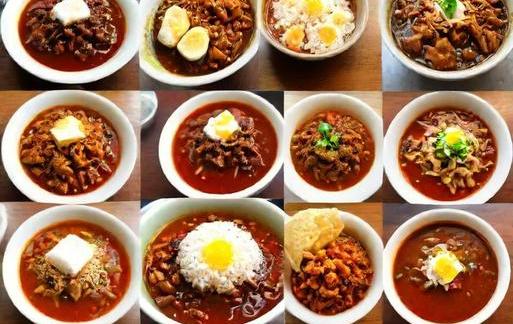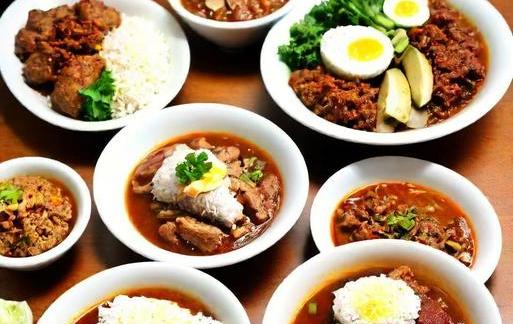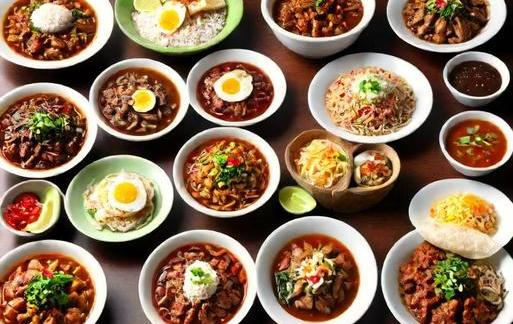- You are here:
- Home »
- Food
- » [REVEALED] Filipino Foods That Start With L
[REVEALED] Filipino Foods That Start With L
Note: This page contains affiliate links.
As an Amazon Associate, I earn from qualifying purchases when you click on the link, but you are not charged extra.
The Philippines, with its rich culinary heritage, boasts a diverse array of flavors and dishes that tantalize the taste buds. From savory to sweet, Filipino cuisine showcases a unique blend of influences, including Spanish, Chinese, and indigenous flavors. In this exploration, we delve into the world of Filipino foods that start with the letter "L." Prepare to embark on a gastronomic journey as we unravel the distinct and delectable offerings that make up this culinary treasure trove.
Contents
List Of Filipino Foods That Start With L

1. Lechon
Description: Lechon, often considered the crown jewel of Filipino celebrations, is a roast pig prepared meticulously for festive occasions. The pig is seasoned with a mix of spices, herbs, and sometimes lemongrass, then slowly roasted over an open fire until the skin turns crispy and golden. The result is succulent, flavorful meat that is typically enjoyed with liver sauce or vinegar for dipping.
2. Laing
Description: Laing is a traditional Bicolano dish originating from the Bicol region. It features dried taro leaves cooked in coconut milk, chili peppers, and a variety of spices. Often prepared with dried fish or shrimp paste, Laing offers a spicy and creamy flavor profile that exemplifies the bold and robust taste of Filipino cuisine.
3. Longganisa
Description: Longganisa is a Filipino-style sausage known for its sweet and garlicky taste. Regional variations exist, with each province having its own distinct recipe. Commonly enjoyed for breakfast, Longganisa is usually paired with garlic fried rice (sinangag) and fried eggs. Some popular types include Vigan, Lucban, and Hamonado, each offering a unique twist to this flavorful sausage.
4. Lumpia
Description: Lumpia is the Filipino version of spring rolls, with variations in preparation and filling. Whether fried or fresh, Lumpia is a versatile dish that can be enjoyed as a snack or a main course. The filling typically includes a mixture of vegetables, meat (such as ground pork or shrimp), and sometimes minced garlic. It is often served with a sweet and savory dipping sauce.
5. Lomi
Description: Lomi is a noodle soup that originated in Batangas and has become a popular comfort food throughout the Philippines. The dish features thick egg noodles, often paired with a rich and flavorful broth made from pork, chicken, and a variety of seasonings. Lomi is then garnished with hard-boiled eggs, pork liver, and vegetables, creating a hearty and satisfying meal.
6. Leche Flan
Description: Leche Flan, also known as caramel custard, is a luscious and creamy dessert that showcases the Filipino sweet tooth. Made with eggs, condensed milk, and vanilla, Leche Flan is steamed until it sets into a smooth and velvety custard. It is then served with a layer of golden caramel syrup on top, adding a delightful contrast of flavors.
7. La Paz Batchoy
Description: Hailing from the city of La Paz in Iloilo, La Paz Batchoy is a noodle soup that features miki noodles, pork organs, and chicharrón (crispy pork skin). The savory broth is flavored with garlic, onions, and sometimes shrimp or beef. La Paz Batchoy has gained popularity across the archipelago, and variations may include additional ingredients like hard-boiled eggs or green onions.
8. Lechon Kawali
Description: Lechon Kawali is a beloved Filipino dish that consists of deep-fried crispy pork belly. The pork is first boiled until tender, then deep-fried until the skin becomes golden and crunchy. It is typically served with liver sauce or vinegar for dipping, creating a satisfying combination of textures and flavors.
9. Linubian
Description: Linubian is a Visayan dish that features marinated and skewered meat, often cooked over an open flame. The marinade includes a mixture of soy sauce, calamansi (Filipino lime), garlic, and other seasonings, imparting a savory and slightly tangy flavor to the meat. Linubian is a popular street food and is commonly enjoyed during local festivals and gatherings.
10. Labong
Description: Labong, or bamboo shoots, are a versatile ingredient used in Filipino cuisine. Commonly found in various regional dishes, Labong adds a unique texture and flavor to soups, stews, and stir-fries. Whether included in a sinigang (sour soup) or combined with coconut milk in a ginataang dish, Labong showcases the diversity and abundance of local ingredients.
Filipino cuisine, with its diverse and vibrant array of dishes, captivates both locals and visitors alike. The foods that start with the letter "L" represent a slice of this culinary landscape, offering a glimpse into the rich tapestry of flavors, textures, and aromas that define Filipino cooking. From the grandeur of Lechon to the comforting warmth of Lomi, each dish tells a story of tradition, innovation, and the love that goes into preparing and sharing meals. Whether you're savoring the crispiness of Lechon Kawali or indulging in the sweetness of Leche Flan, Filipino foods that start with "L" are a testament to the country's culinary prowess and the cultural significance embedded in every bite. So, the next time you find yourself exploring Filipino cuisine, consider seeking out these delightful "L" dishes. Whether you're enjoying them at a festive gathering, a local eatery, or preparing them in your own kitchen, these foods provide a delicious gateway into the heart and soul of Filipino gastronomy.
Significance

The rich and diverse culinary landscape of the Philippines is a reflection of its vibrant culture and history. From savory dishes to sweet delicacies, Filipino cuisine boasts a wide array of flavors and textures.
Understanding the significance of Filipino foods that start with ‘L’ requires a glimpse into the historical and cultural context of the Philippines. Filipino cuisine is a fusion of indigenous flavors with influences from Chinese, Spanish, and American culinary traditions. The letter ‘L’ brings forth a selection of dishes that showcase the Filipino people’s creativity, resourcefulness, and deep connection to their roots.
Category-Related

**1. Lechon
One of the crown jewels of Filipino cuisine is Lechon, a dish that has become synonymous with celebrations and festive occasions. Lechon is a whole roasted pig, marinated and seasoned to perfection before being slowly cooked over an open flame. The result is a crispy skin that encapsulates succulent and flavorful meat. This dish embodies the Filipino spirit of hospitality, often served during weddings, birthdays, and holidays.
2. Laing
Hailing from the Bicol region, Laing is a spicy dish that features dried taro leaves cooked in coconut milk, chili peppers, and a medley of aromatic spices. The combination of creamy coconut and the earthy flavor of taro leaves creates a uniquely Filipino taste. Laing is a testament to the country’s use of local ingredients and innovative cooking methods, making it a favorite among those who appreciate bold and robust flavors.
3. Longganisa
Filipino breakfasts wouldn’t be complete without Longganisa, a type of sausage that varies in flavor and style across different regions of the Philippines. Each province has its own take on Longganisa, with variations ranging from sweet to garlicky to spicy. Made from ground pork, Longganisa is often paired with garlic rice and fried eggs, offering a delightful combination of savory and slightly sweet notes.
4. Lumpia
Lumpia is a beloved Filipino spring roll that comes in various forms. Whether fried or fresh, Lumpia is a versatile dish that can be filled with a variety of ingredients, such as minced meat, vegetables, and sometimes even ubod (heart of palm). Often served with a sweet and savory dipping sauce, Lumpia is a favorite appetizer or snack during gatherings and celebrations.
5. Lomi
Lomi is a noodle soup that originated in the Batangas region. What sets Lomi apart is its thick and chewy noodles, combined with a flavorful broth made from pork, chicken, and sometimes beef. The dish is further enriched with the addition of vegetables, meat, and a hard-boiled egg. Lomi is a comfort food that warms the soul, making it a popular choice, especially during rainy days.
Common Themes
1. Local Ingredients
A common theme across many Filipino foods that start with ‘L’ is the use of locally sourced ingredients. Whether it’s the taro leaves in Laing, the coconut milk in various dishes, or the unique flavors of regional Longganisa, Filipino cuisine emphasizes the abundance of ingredients available in the archipelago. This connection to local produce not only enhances the flavors but also reflects the Filipino commitment to sustainability and self-sufficiency.
2. Celebration And Togetherness
Lechon, Longganisa, and Lumpia are often associated with celebrations and gatherings. These dishes have become integral parts of Filipino festivities, symbolizing joy, togetherness, and the warmth of hospitality. The act of sharing a meal is deeply ingrained in Filipino culture, and dishes that start with ‘L’ play a significant role in bringing people together, strengthening bonds, and creating lasting memories.
3. Adaptability And Creativity
Filipino cuisine is known for its adaptability and creativity, evident in the variety of interpretations seen in dishes like Lumpia. The adaptability of Filipino cooks is showcased through the different regional versions of Longganisa, each with its own unique blend of flavors. This creativity not only adds diversity to the culinary landscape but also reflects the resourcefulness of Filipino cooks in utilizing available ingredients to create delightful and satisfying meals.
Interesting Facts
1. Lechon’s Cultural Symbolism
Lechon goes beyond being just a delicious dish; it holds cultural significance in Filipino society. Often associated with fiestas and special occasions, the act of roasting a whole pig is considered a grand display of generosity and hospitality. In fact, the town of Balayan in Batangas is renowned for its annual Lechon Festival, where locals showcase their culinary skills in preparing this iconic dish.
2. Laing’s Bicolano Roots
Laing’s roots trace back to the Bicol region, known for its affinity for spicy dishes. The dish originated from the necessity to preserve taro leaves during the abundant harvest season. By cooking them in coconut milk and spices, the locals found a way to create a flavorful and long-lasting dish. Today, Laing stands as a testament to Bicolano ingenuity and their love for bold and spicy flavors.
3. Longganisa Varieties Across The Archipelago
Longganisa comes in a multitude of varieties across the Philippines, showcasing the country’s cultural diversity. From the sweet and sticky Longganisa of Vigan to the garlicky and savory Longganisa of Lucban, each region adds its own twist to this breakfast staple. Exploring the different Longganisa varieties is like embarking on a culinary journey through the archipelago, each bite telling a story of local traditions and flavors.
4. Lumpia’s Historical Journey
Lumpia has a fascinating historical journey, believed to have been introduced to the Philippines by Chinese traders. Over time, Filipinos adapted and personalized the dish, creating their own versions with local ingredients. Whether fried as Lumpiang Shanghai or fresh as Lumpiang Ubod, the versatility of Lumpia reflects the dynamic nature of Filipino cuisine and its ability to assimilate foreign influences into something uniquely Filipino.
5. Lomi’s Evolution Through Generations
Lomi has evolved over the years, with each generation adding its own touch to the dish. What started as a simple noodle soup has transformed into a comfort food loved by many. The thick noodles, rich broth, and diverse ingredients used in Lomi highlight the adaptability of Filipino cuisine to changing tastes while maintaining a deep connection to traditional flavors.
Conclusion
Filipino foods that start with the letter ‘L’ offer a captivating journey through the heart of Filipino cuisine. From the iconic Lechon, symbolizing grand celebrations, to the spicy Laing, showcasing Bicolano ingenuity, each dish tells a story of culture, history, and a deep connection to local ingredients. The common themes of using local produce, celebrating togetherness, and showcasing adaptability and creativity are woven into the culinary fabric of the Philippines.
As we explore the interesting facts surrounding these dishes, we gain insights into the cultural symbolism of Lechon, the regional diversity of Longganisa, the historical journey of Lumpia, and the evolving nature of Lomi. Filipino cuisine, with its fusion of flavors and influences, stands as a testament to the resilience and creativity of the Filipino people.
In every bite of Lechon, every savor of Laing, every crunch of Lumpia, and every slurp of Lomi, one can taste the essence of the Philippines – a nation with a rich culinary heritage that continues to evolve, adapt, and delight the taste buds of those fortunate enough to experience its gastronomic wonders.


